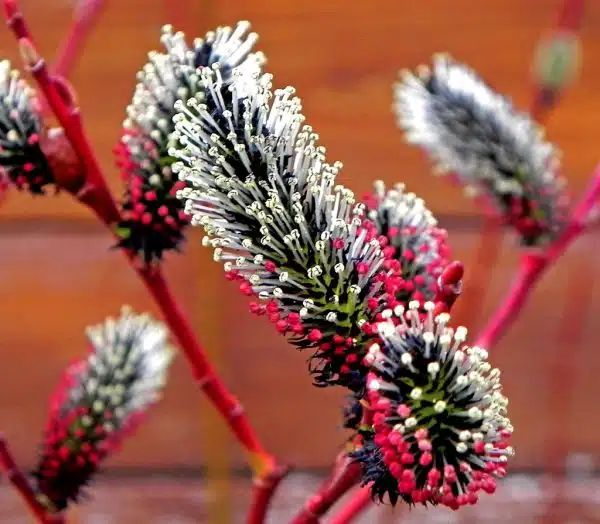Black Willow (Salix nigra) is a deciduous tree that is native to North America. It is commonly found in wetlands, along riverbanks, and in other areas with high moisture content. This tree is a popular choice for people who want to grow a fast-growing shade tree that can tolerate wet soils.
Growing and caring for Black Willow requires attention to several key factors. Proper site selection, soil preparation, and maintenance are all important aspects of ensuring the health and longevity of this tree. In this article, we will discuss the steps necessary to successfully grow and care for Black Willow, including its optimal growing conditions, common pests and diseases, pruning techniques, and more. Whether you are an experienced arborist or a novice gardener, this guide will provide you with the knowledge you need to cultivate a healthy and thriving Black Willow tree.
Understanding Black Willow: Characteristics And Benefits
Black willow, or Salix nigra, is a deciduous tree native to North America. It is known for its slender, graceful appearance and its ability to thrive in wet environments. The black willow can grow up to 80 feet tall with a trunk diameter of up to 3 feet. Its leaves are long and narrow, measuring up to 6 inches in length.
Uses and applications of the black willow include erosion control along riverbanks and ponds, as well as for medicinal purposes. The bark of the tree contains salicin, which has pain-relieving properties similar to aspirin. Black willow extract is also used in skin care products due to its anti-inflammatory benefits. Additionally, the strong but flexible wood of the black willow is used in basket weaving and other crafts.
The environmental significance of the black willow cannot be overlooked. This species contributes greatly to riparian ecosystems by stabilizing soil along waterways and providing habitat for a variety of wildlife such as birds, insects, and small mammals. Its roots help prevent erosion while also absorbing excess nutrients from runoff that could otherwise harm aquatic life. As such, planting black willows can be an important part of restoring damaged ecosystems or creating new ones.
When it comes to growing your own black willow tree, choosing the right site is crucial for ensuring its health and longevity. In the following section, we’ll explore how to select the perfect spot for your tree based on factors such as soil type, sunlight exposure, and moisture levels.
Site Selection: Finding The Perfect Spot For Your Black Willow Tree
When selecting a site for a black willow tree, the location should be considered carefully. The soil type should be moist and well-draining, as the tree does not tolerate standing water. Optimal growth occurs in a location that receives full sun for at least part of the day. Additionally, proper drainage is necessary for the tree to thrive.
Location
Black willow trees, also known as Salix nigra, are a great addition to any landscape or garden. They are fast-growing and typically reach heights of up to 50 feet tall. When selecting the perfect spot for your black willow tree, it is important to consider the location carefully. The best climate for these trees is in areas with mild to warm temperatures, as they do not fare well in extreme cold.
Black willows require full sun exposure in order to thrive. This means that they should be planted in an area where they can receive at least six hours of direct sunlight every day. It is also important to consider the soil quality and drainage when selecting a site for planting. Black willows prefer moist soil conditions, but they can tolerate drier soils as well.
When choosing a location for your black willow tree, it is important to take into account its eventual size and growth habit. These trees have extensive root systems that can spread up to three times their height, so it is best to plant them away from buildings or other structures that may be damaged by their roots. With proper care and attention, black willows can grow into stunning specimens that provide shade and beauty for many years to come.
Soil Type
When selecting a site for planting a black willow tree, the soil type is an important factor to consider. Black willows prefer moist, well-draining soil conditions with a pH range of 6.0-8.0. It is essential to test the soil before planting to determine its pH level and improve it if necessary.
The soil’s drainage management also plays an important role in the survival and growth of black willows. Poorly drained soils can lead to root rot and other issues that may harm the tree’s overall health. To ensure proper drainage, it is recommended to plant black willows on elevated ground or in areas with natural slopes that allow water to drain away from the roots.
In summary, selecting the right soil type and managing drainage are crucial factors in determining the perfect spot for planting a black willow tree. By ensuring these requirements are met, one can provide an optimal growing environment for this fast-growing tree species, resulting in healthy growth and stunning beauty for years to come.
Soil Preparation: Creating The Ideal Growing Conditions
While some may argue that black willows can grow just about anywhere, the truth is that they thrive in specific conditions. As a dedicated horticulturist, it is imperative to create the ideal growing conditions for salix nigra to flourish. This starts with soil preparation.
One of the most beneficial steps you can take when preparing soil for black willow is composting. Composting benefits your plants by providing them with rich and nutrient-dense soil. It also promotes healthy microbial activity and improves water retention in the soil. You should aim to use at least two inches of high-quality compost in your soil preparation process.
Another useful tip is to consider raised bed gardening for your black willow trees. Raised beds offer a range of benefits, including improved drainage, better root development, and more efficient use of space. By elevating your planting area above ground level, you can avoid issues with compacted soil and increase air circulation around the roots.
With these techniques in mind, you can create an ideal growing environment for salix nigra that encourages healthy growth and maximum yield. Of course, this is just one step in a larger process of caring for your black willow trees. In the next section, we’ll explore how watering and fertilization can provide the right nutrients for growth while protecting against common pests and diseases.
Watering And Fertilization: Providing The Right Nutrients For Growth
Black willow is a tree species that prefers moist soil conditions, and deep watering promotes its growth. During dry months, it is essential to water the tree once every week to maintain moisture levels in the soil. The frequency of watering can be reduced during rainy seasons as the trees receive a natural supply of water. However, it is important to ensure that the soil remains consistently moist but not waterlogged. Deep watering ensures that the roots grow deeper into the ground, strengthening the foundation of the tree.
Organic fertilizers are preferred over chemical fertilizers when it comes to growing black willow trees. Organic fertilizers provide essential nutrients to the tree while also enriching the soil with beneficial microbes, promoting healthy growth. It is recommended to use fertilizers like compost or manure at least twice a year during spring and fall. These organic fertilizers release nutrients slowly into the soil, providing long-lasting benefits to black willow trees.
Incorporating organic matter into the soil helps retain moisture and provide essential nutrients for black willow growth. Additionally, using mulch around the base of these trees helps retain moisture in dry conditions while suppressing weed growth around them. By ensuring consistent deep watering and using organic fertilizer regularly, black willow trees can grow strong and healthy for many years to come.
Moving forward, it’s important to understand common pests and diseases that may affect black willows so you can identify and treat issues promptly.
Common Pests And Diseases: Identifying And Treating Issues
Black willows are generally healthy trees, but they can be susceptible to a few pests and diseases. One of the most common problems is willow blight caused by the fungus Cryptosporiopsis salicinum. This disease causes leaves to turn brown and wilt, eventually killing entire branches. To prevent this disease, it’s essential to avoid overhead watering, maintain good tree health through proper pruning and fertilization, and remove infected branches at the first sign of symptoms.
Another common pest that affects black willows is the willow sawfly larvae. These insects feed on leaves, causing defoliation that can weaken the tree over time. To control these pests, use preventative measures such as removing leaf litter from around the base of trees or using insecticidal soap sprays early in the season before sawflies have hatched. For organic remedies, try introducing natural predators such as ladybugs or lacewings into your garden.
In addition to these issues, black willows can also suffer from root rot caused by overly wet soil conditions. To avoid this problem, plant your tree in well-draining soil and ensure proper drainage around the roots. If you suspect your tree has root rot, remove any damaged roots and treat with a fungicide as necessary. Vigilance and quick action are key to keeping your black willow healthy and vibrant for years to come.
As we have seen above, identifying pests and diseases that affect black willows is crucial for maintaining their health. Preventative measures such as proper pruning techniques can help reduce opportunities for infection or infestation while organic remedies like introducing natural predators can provide an eco-friendly solution to pest control. In our next section on pruning techniques: promoting healthy growth and shape, we’ll explore how strategic trimming can enhance your tree’s visual appeal while ensuring its long-term vitality.
Pruning Techniques: Promoting Healthy Growth And Shape
Pruning is an essential step in maintaining a healthy black willow tree. Pruning frequency depends on the tree’s age, health, and growth rate. On average, pruning every three years can help in promoting healthy growth and shape. However, it’s important to assess the tree annually to determine if pruning is necessary.
Shaping techniques should be employed during pruning to ensure that the tree maintains its natural form. When shaping, it’s crucial not to remove more than 25% of the live crown at once as doing so can damage the tree’s structural integrity. Instead, focus on removing dead or diseased branches and those that are crossing or rubbing against each other.
Pruning should be done during the dormant season when the tree is not actively growing. This timing ensures that cuts will heal faster and with less chance of disease or pest infestation. Proper pruning techniques can prevent future problems from developing while promoting healthy growth and shape for your black willow tree.
To propagate black willows, you can use either cuttings or seeds. Cuttings should be taken from hardwood in late winter or early spring while seeds should be collected in autumn after they have matured on the tree. Once you have obtained your cuttings or seeds, follow specific steps for each method to ensure successful propagation.
Propagation Methods: Growing Black Willow From Cuttings Or Seeds
Black willows can be propagated through cuttings or seeds. Propagating black willows from cuttings is a reliable method that ensures genetic uniformity in the new plants. To propagate black willow from cuttings, select a healthy branch from the parent plant and make a clean cut at a 45-degree angle below a leaf node. The cutting should be around 6-8 inches long and have at least three sets of leaves. Dip the lower end of the cutting in rooting hormone powder and plant it in sterile soil mix, keeping it moist until roots form.
Propagation techniques such as using rooting hormones can enhance root development and increase success rates when growing black willow from cuttings. Rooting hormones like indole-3-butyric acid (IBA) can help stimulate root growth, while other hormones like naphthaleneacetic acid (NAA) are used to promote lateral bud formation. When selecting soil types for propagating black willow, it is best to use well-draining soils such as sand, perlite, or vermiculite mixed with peat moss.
In addition to propagating black willow from seeds or cuttings, companion planting can also help them thrive. Companion planting involves choosing plants that grow well together and provide mutual benefits such as pest control or nutrient uptake. In the subsequent section, we will explore some companion plants that grow well with black willow and how they can benefit each other.
Companion Planting: Choosing Plants That Thrive With Black Willow
- In order to create a balanced ecosystem when planting Black Willow, it is important to consider the beneficial relationships that can be established between different plants, soil organisms, and pollinators.
- Identification of beneficial plants to accompany Black Willow is essential, as they can provide increased soil fertility, pest control, and improved water retention capabilities.
- When planting for pollinators, it is important to consider the flowering times of the accompanying plants, as well as the size and shape of their flowers, to ensure that the desired pollinators will be attracted.
- Care should be taken to ensure that plants that compete with the Black Willow for resources are not planted too close.
- Planting companion plants in the vicinity of the Black Willow can also provide additional shelter and shade, as well as helping to reduce the amount of water lost through evaporation.
- To ensure the long-term health of the Black Willow, consideration should be given to planting companion plants that are well-suited to the local climate and soil conditions.
Creating A Balanced Ecosystem
The black willow, also known as Salix nigra, is a fast-growing tree that requires little maintenance once established. However, to ensure optimal growth and health of the tree, it is important to create a balanced ecosystem in its surroundings. This can be achieved through companion planting, where different plants are strategically placed to provide mutual benefits.
One of the main benefits of biodiversity in companion planting is that it attracts a variety of beneficial insects and pollinators. These insects help with natural pest control and fertilization, which reduces the need for harmful chemicals and promotes overall plant health. Some great companion plants for black willow include sunflowers, wildflowers, and milkweed.
In addition to providing a habitat for beneficial insects, companion planting can also improve soil quality by increasing nutrient availability and reducing erosion. By choosing plants that have different root structures and nutrient needs, the soil is able to maintain a healthy balance. Overall, creating a balanced ecosystem through companion planting not only benefits the black willow but also promotes environmental sustainability and supports pollinator populations.
Identifying Beneficial Plants
As horticulturists and arborists, it is essential to identify the beneficial plants that thrive with black willow. Companion planting has many benefits, including attracting beneficial insects and improving soil quality. However, choosing the right plants is crucial for optimal growth and health of both the black willow and its companion plants.
One such beneficial plant is chamomile, which provides numerous benefits to the surrounding ecosystem. Chamomile attracts pollinators such as bees and butterflies, making it a great choice for companion planting with black willow. Additionally, chamomile has natural pest-repellent properties that can help protect other plants in the area from harmful insects.
Another excellent companion plant for black willow is lavender, especially for beginners in gardening. Lavender has a beautiful aroma and vibrant colors that make it an attractive addition to any garden or landscape. Moreover, lavender helps repel pests like mosquitoes and flies while attracting pollinators like bees and butterflies. Furthermore, growing lavender requires little maintenance once established, making it ideal for novice gardeners who want to add beauty to their gardens while also supporting environmental sustainability through companion planting.
Planting For Pollinators
Companion planting plays a vital role in creating a diverse and sustainable ecosystem. Choosing the right plants to grow alongside black willow is crucial for optimal growth and health. One way to achieve this is by planting for pollinators, such as butterflies and bees. These insects play an essential role in pollinating plants, ensuring their reproduction and survival.
Attracting butterflies to your garden or landscape has several benefits. Butterflies are not only beautiful to look at, but they also help pollinate plants while serving as food sources for other animals, including birds. Creating habitat for these winged creatures is relatively easy, requiring the planting of nectar-rich flowers that attract them. Some suitable companion plants for black willow that attract butterflies include milkweed, butterfly weed, and aster.
In addition to attracting butterflies, creating habitat for these insects can also improve biodiversity in your garden or landscape. By incorporating various plant species that provide nectar throughout the growing season, you can create a thriving ecosystem that supports multiple plant and animal species. This approach also helps reduce the use of harmful chemicals in gardening practices while promoting environmental sustainability through companion planting with black willow.
Harvesting And Uses: Utilizing Black Willow For Medicinal Or Decorative Purposes
Companion planting with black willow can be likened to a partnership between two individuals who complement each other’s strengths and weaknesses. When planted alongside other species, such as red osier dogwood or meadowsweet, black willow can thrive and provide a host of benefits to its companions. These benefits include improved soil health, increased pollinator activity, and enhanced resistance to disease and pests.
Once established, caring for black willow is relatively low maintenance. However, proper pruning techniques and regular watering are essential to ensure its growth and longevity. In terms of harvesting, the best time to gather the bark is during early spring when the sap is flowing. Drying techniques vary depending on the intended use of the bark but generally involve air-drying in a cool, dry place away from direct sunlight.
Black willow has a long history of medicinal use by indigenous communities for treating various ailments such as headaches and fevers. DIY projects using black willow bark include creating tinctures or teas for internal use as well as salves or poultices for external applications. Additionally, black willow can be used for crafting items such as baskets or furniture due to its flexible branches and durable wood. With some creativity and ingenuity, there is no limit to what you can create with this versatile tree.
As with any plant species, black willow may encounter common issues such as pests or diseases that can affect its health and growth. Troubleshooting these problems involves identifying the cause of the issue and implementing appropriate measures such as pruning affected areas or applying organic pest control methods. By actively monitoring your black willow tree’s health and addressing any concerns promptly, you can ensure it continues to thrive for years to come while reaping its many benefits.
Troubleshooting: Addressing Common Issues And Concerns In Black Willow Care
Preventing rot is a crucial aspect of black willow care. This tree species thrives in moist soil and can be prone to fungal infections if not kept in check. One way to prevent rot is by ensuring that the soil around the base of the tree has good drainage. This can be achieved by adding organic matter into the soil or planting the tree on a slight incline. Additionally, avoid overwatering as this can create stagnant water that invites fungi.
Dealing with leaf drop is another common issue in black willow care. If you notice your tree shedding leaves excessively, it may be due to environmental stressors such as drought or extreme heat. Inadequate nutrition can also cause leaf drop in black willows. To address this issue, ensure that your tree receives adequate water and nutrients from fertilizers. Additionally, consider pruning any dead or diseased branches from the tree to promote healthy growth.
It’s important to remember that every black willow is unique and may require specific care depending on its environment and individual characteristics. By regularly monitoring your tree for signs of stress or disease, you can quickly address any issues that arise and keep your black willow healthy for years to come. With proper care, these trees provide beauty and shade while contributing positively to their surrounding ecosystems.
Conclusion
Black willow (Salix nigra) is a species of tree that provides many benefits to gardeners and homeowners. With its fast growth rate, this tree can quickly establish itself in a variety of landscapes, including wetlands and riverbanks. However, to ensure its success, proper care must be taken during planting and maintenance.
Site selection is crucial for black willow trees as they thrive in moist soil conditions. Once the ideal location has been found, soil preparation should be done to create an environment that promotes growth. Regular watering and fertilization are also essential for maintaining healthy trees.
While black willows are generally hardy plants, there are several pests and diseases that can affect them. Proper identification of these issues and prompt treatment is important to prevent any serious damage. Propagation methods such as cuttings or seeds can also be used to expand your black willow population.
Companion planting with other species that thrive in similar conditions can also benefit black willows. Harvesting the wood for medicinal or decorative purposes is another way to utilize this versatile tree. However, it’s important to address any concerns or issues through troubleshooting techniques.
In conclusion, growing and caring for black willow requires attention to site selection, soil preparation, watering/fertilization schedule, pest/disease identification and treatment methods, propagation techniques, companion planting strategies as well as harvesting/uses of the wood. As horticulturists or arborists we recognize the unique characteristics of this species – fast growth rate and thriving in moist soil conditions- and by following proper care guidelines we can create a beautiful landscape painting with these majestic trees at the forefront.
Image Credits
- “Black Pussy Willow…It’s Finally Spring” by Hawaiian Sea (featured)





























